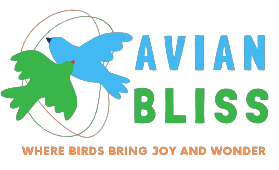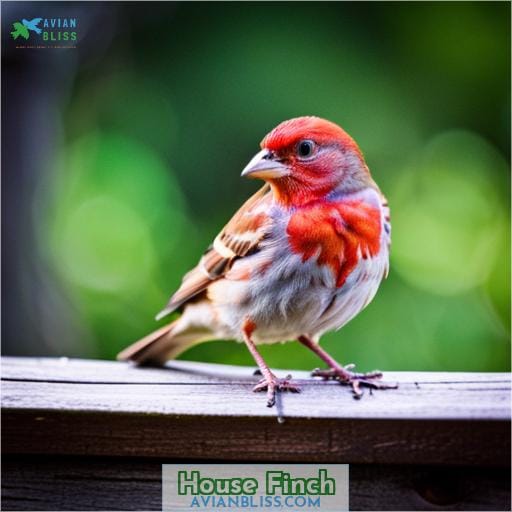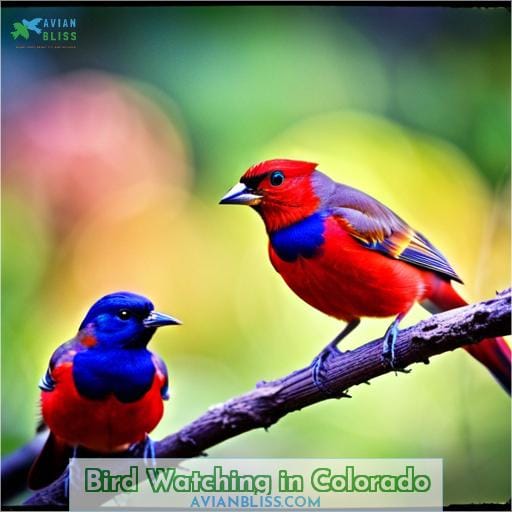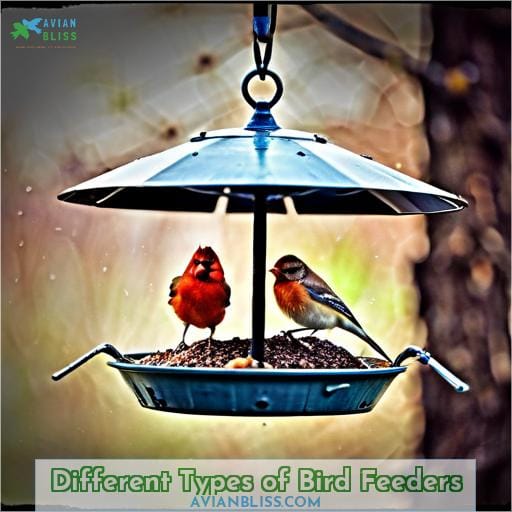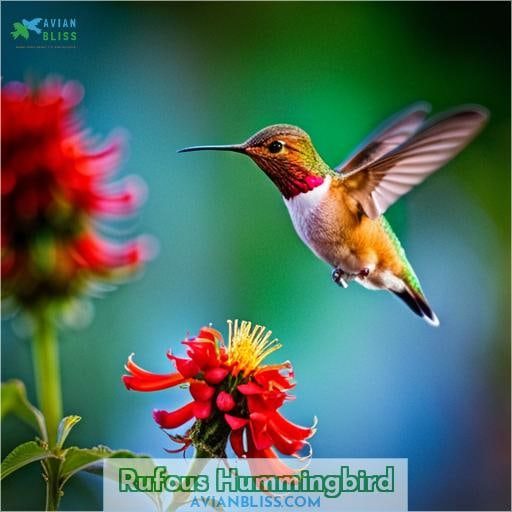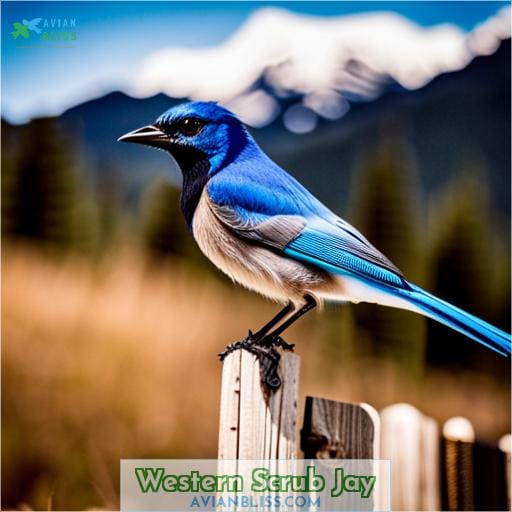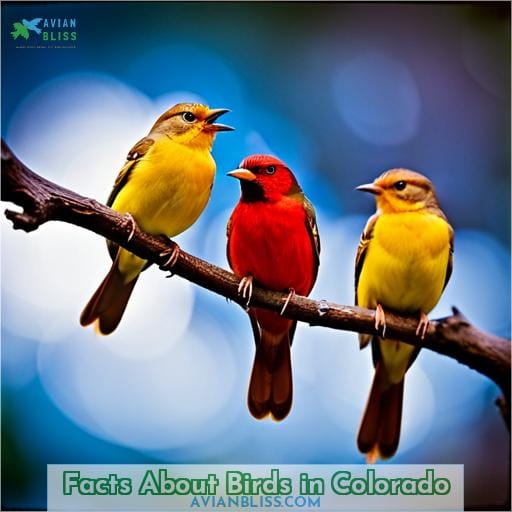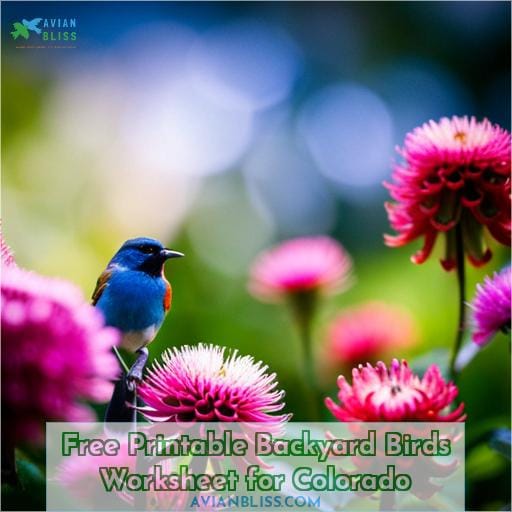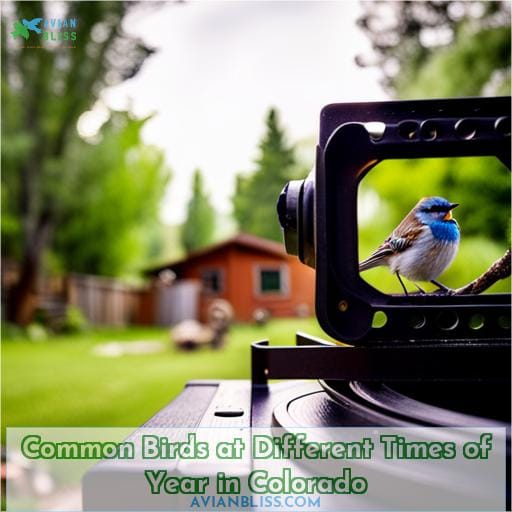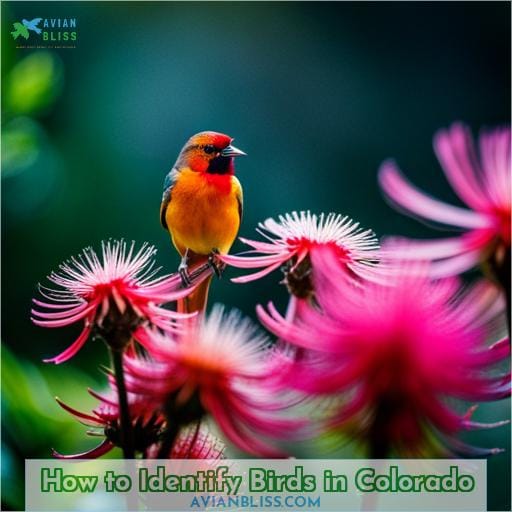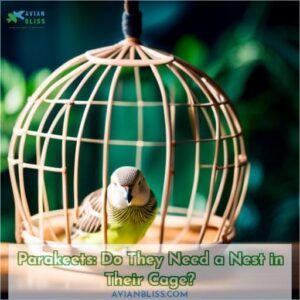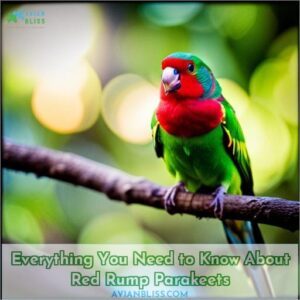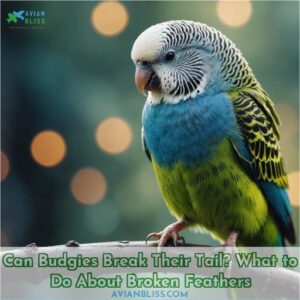This site is supported by our readers. We may earn a commission, at no cost to you, if you purchase through links.
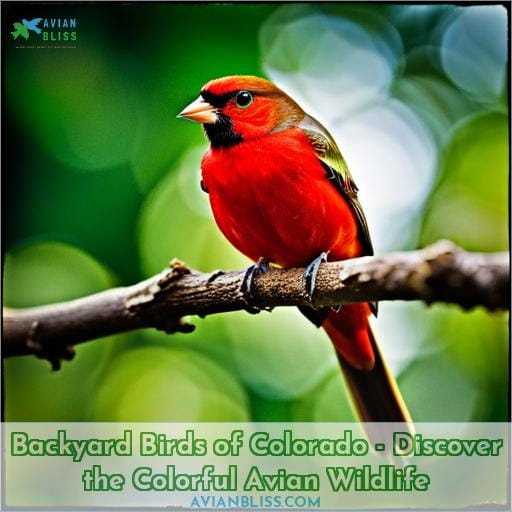 Exploring the vibrant beauty of Colorado’s backyard birds is an adventure worth taking! From House Finches to Rufous Hummingbirds, there are a variety of colorful avian species that inhabit this state.
Exploring the vibrant beauty of Colorado’s backyard birds is an adventure worth taking! From House Finches to Rufous Hummingbirds, there are a variety of colorful avian species that inhabit this state.
Whether you are looking for tips on birdwatching or want to learn about the different types of feeders available, this guide will equip you with all the necessary knowledge and resources so you can create your own backyard oasis for these feathered friends.
Table Of Contents
Key Takeaways
- Colorado is home to nearly 300 bird species.
- Bird watching in Colorado provides opportunities to observe diverse species.
- Different types of bird feeders will attract various species.
- Planting native plants that provide shelter is recommended.
House Finch
You love the lively chatter of birds outside your window. If you pay attention, you may spot a few familiar urban backyard birds of Colorado, such as a plump Mourning Dove, a gregarious European Starling, a perky Black-capped Chickadee, an industrious White-breasted Nuthatch, or a mischievous Black-billed Magpie.
The birds provide a welcome respite from the hustle and bustle of daily life. Their songs and antics can brighten even the dreariest day. Take a moment to appreciate the feathered friends flocking to your yard. Their presence is a reminder that beauty and nature exist all around us, even in the midst of urban living.
Mourning Dove
You’d be amazed to learn that mourning doves can fly up to 55 miles per hour! These gentle backyard visitors display incredible aerobatics with their soft coos and swift wings that bring peace. Mourning doves favor seeds and fruits, often visiting platform feeders. They build flimsy stick nests in trees or on the ground.
Their mournful song and delicate beauty inspire artists worldwide. Some believe doves symbolize hope and new beginnings. Watch for their graceful flight and listen for their soothing call. Mourning doves brighten backyards with their peaceful presence and gentle spirit across Colorado.
European Starling
Though starlings may not be native, you’ve likely spotted their sizable flocks and iridescent feathers across Colorado’s urban and rural areas.
| Habitat | Diet | Behavior |
|---|---|---|
| Lawns, parks, farms | Insects, fruit | Gregarious, aggressive |
| Nest in cavities | Seeds, suet | Skilled vocal mimics |
| Roost in dense trees | Bird eggs, chicks | Form permanent, socially monogamous pairs |
With extremely large populations, starlings compete with native cavity-nesters. Use deterrents and remove unattended nests to limit their impacts.
Black-capped Chickadee
I see the tiny Black-capped Chickadee snatch those sunflower seeds from your tube feeder and fly off to stash them in the pine trees. These energetic birds flit about acrobatically, clinging upside down while probing bark crevices.
Their chick-a-dee-dee-dee call reveals their presence. They prefer deciduous or mixed woods with mature trees to nest in natural cavities or birdhouses. Chickadees eat insects, seeds, berries. Tube feeders with small perches suit them well.
Offering black oil sunflower seeds will surely attract them. With proper habitat, you can enjoy their curiosity, acrobatics, and cheerful song.
White-breasted Nuthatch
You’ll be pleased to spot the agile White-breasted Nuthatch scurrying up and down tree trunks as it searches for insects in your yard. This small gray bird with white underparts and a long pointed bill forages busily.
Place birdhouses 15-20 feet high on oak or pine trees to attract breeding pairs. Capture nuthatch antics and acrobatics in avian snapshots.
Join fellow naturalists contributing data for bird research and habitat protection. Savor the industrious nuthatch’s quirky charm enlivening your backyard sanctuary.
Black-billed Magpie
Tis a sight when that mischievous Black-billed Magpie lands on your homemade bird bath.
- Magpies are highly intelligent and can mimic sounds.
- They mainly eat insects, fruits, seeds and small rodents.
- Magpies build large nests high up in trees using twigs and mud.
- The black and white plumage are identifying features.
Seeing magpies means spring has sprung in Colorado. Their frequent visits add entertainment while you fill the bird bath with fresh water and chunks of orange.
Bird Watching in Colorado
Bird watching in Colorado offers exciting opportunities to observe a diversity of species across various natural habitats. To attract colorful songbirds, woodpeckers, and other backyard birds of Colorado to your own property, provide a range of feeders with preferred seeds and suet, supply fresh water in a birdbath, and add native shelter-providing plants.
Shelter can be provided by planting native shrubs and trees. Varying feeder locations and types will attract different species. Sitting quietly with binoculars near feeders and sources of water allows close observation of individual birds and their behaviors.
Patience is required, but attentive bird watching can reveal hidden gem moments.
Colorado Birding Locations
Seeking rare species or daily backyard visitors, venture through urban greenbelts and alpine meadows where winged sprites flit between flower and branch. The Dixon Creek riparian corridor by Clear Creek offers refuge for warblers and crossbills.
In spring, flock to Barr Lake’s wetlands bursting with ibis and avocets. Come winter, Purgatoire River’s piñon-juniper woodlands host rosy-finches and Townsend’s solitaires. Wherever you wander, pause and breathe in Colorado’s high-altitude air, scanning the skies with keen eyes and a gentle heart.
Tips to Attract Birds
Take notice when your soul delights at the sight of a curious chickadee pecking at the feeder you lovingly filled just for them. Strategically place bird feeders to provide birds nourishment and yourself endless entertainment.
Position birdhouses in quiet, secluded spots for desired inhabitants. Include water sources like birdbaths where feathered friends can drink and bathe. Deter squirrels from stealing birdseed with specialized feeders. Embrace native plants that shelter and sustain wildlife.
Select feeders tailored to different birds – oriole, hummingbird, thistle, suet, platform.
Providing Water Sources
You’d be surprised that over 300 bird species can be found along Colorado’s Front Range, so providing clean water sources like birdbaths helps attract various species to your yard.
- Keep bird baths clean to prevent disease spread
- Place birdbaths near foliage for approaching/departing cover
- Use materials like concrete, metal, plastic or glazed ceramic
- Include varying depths and textured surfaces for all birds
- Water, especially moving water, entices species like nuthatches, downy woodpeckers, mourning doves
Clean, well-located birdbaths with fresh water can draw in species and provide enjoyment for nature lovers.
Importance of Birdhouses
Installing some birdhouses is vital for attracting more species to your yard, especially in Colorado’s treeless areas. Pick sturdy houses with tight openings to keep predators out. Mount them 5-15 feet high facing away from prevailing winds.
Clean annually before nesting season. Add some flare with paint or natural embellishments. Proper bird care brings in chickadees, wrens, swallows and more. You’ll be rewarded watching adorable hatchlings chirp each morning.
Creating Shelter
You’re staking a claim to wilderness when making a haven amid the concrete jungle. Craft roosting spots with weather-resistant designs like pinecones, bricks, and clay pots. Position birdhouses facing east at optimal heights on trees to mimic natural habitats.
Leave brush piles beneath pinyon-juniper forests and sub-alpine meadows. DIY shelters encourage backyard birds.
Different Types of Bird Feeders
Our hearts fill with joy as we watch the birds flutter to the feeders we lovingly filled.
Tube feeders attract finches, chickadees, and sparrows with thistle or nyjer seed. Their transparent design allows close-up viewing while limiting squirrel access.
Window feeders provide an intimate front-row seat to birdwatching.
Suet feeders draw woodpeckers and nuthatches for nutritious suet cakes.
Consider less common nyjer feeders, perfectly sized for tiny nyjer seeds and ideal for goldfinches.
Lastly, a simple bird bath meets a critical need for bathing and hydration in Colorado’s dry climate.
Listening to their joyful songs and watching their energetic antics, we’re reminded of life’s simple pleasures.
Rufous Hummingbird
You can catch a glimpse of the feisty Rufous hummingbird zipping around your garden in the Rocky Mountains from spring through fall. These tiny birds migrate over 2,000 miles from Mexico, fueled by flower nectar and sugar-water feeders.
To draw them in, hang nectar feeders with perches in bright colors like red. Use a 1:4 ratio of sugar to water and clean feeders weekly. Plant tubular flowers that provide nectar like bee balm, columbine, and trumpet vines.
Rufous hummers aggressively defend nectar sources, so space multiple feeders around your yard.
With lightning speed, they can be challenging to photograph. If you’re lucky, a female may build a tiny lichen-covered nest on your porch or in a tree before migrating south again in late summer.
Western Scrub Jay
Holding their crest high, the charismatic Western Scrub Jay frequents Colorado backyards seeking peanuts and sunflower seeds. Known for intelligence and adaptability, these resourceful jays occupy deserts, mountains, and neighborhoods along the Front Range.
Foraging on the ground, Western Scrub Jays consume insects, seeds, fruits, and small animals. To store extra food, they hide snacks in crevices and under debris. Gregarious and territorial, family groups work together to defend their habitat.
Though habitats are threatened by development, they thrive in rural parks and backyards. With messy twig nests built low in bushes, a clutch of pale blue-green eggs will hatch in spring. To support Western Scrub Jay populations, install native shrubs and avoid pesticides.
Offer peanuts, berries, and fresh water – these personality-filled jays will reward you with beauty, curiosity, and companionship.
Facts About Birds in Colorado
Here in Colorado, we’re blessed with a diverse ecosystem that supports nearly 300 species of birds. From the grasslands to the rocky peaks, opportunities abound to encounter our feathered friends. Offering seeds or fresh water can draw birds close – a gift for bird lovers. Species like the black-capped chickadee, mountain bluebird, and American goldfinch visit backyard feeders, while the belted kingfisher and common goldeneye prefer lakes and rivers.
Providing birdhouses assists tree nesters like western bluebirds. Patience watching at dawn may reward you with a glimpse of the northern harrier gliding low over fields. Embracing birdwatching rewards you with a glimpse into Colorado’s intricate web of life.
Our native birds bring color, song, and benefit to the land, so take a moment to appreciate them. They’re an essential part of our environment and culture here. Whether building birdhouses, filling feeders, or patiently watching, engaging with our feathered neighbors connects us to the natural rhythms of the land.
With so much diversity, there’s always more to discover about the families who share our Colorado home.
Free Printable Backyard Birds Worksheet for Colorado
Checking over our printable backyard birds identification sheets, you’ll easily reference local species while enjoying Colorado’s colorful avian friends. Study the field guide illustrations of birds spotted at backyard feeders, nesting in trees, soaring over prairies, and foraging in alpine meadows.
Learn to identify bald eagles, golden eagles, red-tailed hawks, American kestrels, turkey vultures, and more using the helpful tips. Select the best bird feeders and seed types to attract certain species. Get recommendations for bird-friendly native plants that provide food and shelter.
Discover how you can get involved in bird conservation efforts like monitoring migration routes and protecting wetland habitats. Grab your binoculars and put your new birdwatching knowledge into practice as you appreciate the remarkable diversity of backyard birds throughout Colorado’s varied landscapes.
Common Birds at Different Times of Year in Colorado
In spring, you’ll hear the buzzy trill of broad-tailed hummingbirds as they arrive to breed.
Watch for the flash of orange on male black-headed grosbeaks mingling with other migrants like orange-crowned warblers in mountain forests.
By summertime, bluebirds, sparrows, and finches are busy raising their young across the state.
In fall, sandhill cranes gather by the thousands near Monte Vista, fueling up before their long journey south.
As winter sets in, chickadees, jays, and woodpeckers frequent backyard feeders.
The diversity of species changes with the seasons as birds migrate through or settle in Colorado according to yearly rhythms and climate patterns. With a keen eye and ear, you can find feathered friends in the Front Range year-round.
How to Identify Birds in Colorado
You’ll recognize the bright orange breast and black hood of the American goldfinch as it hovers brightly over thistle feeders. To identify birds in Colorado’s diverse habitats, arm yourself with some essential birding tools.
Invest in a good pair of binoculars to distinguish details like beak shape and feather patterns. Download field guide apps with bird songs and calls to aid identification by sound.
Start learning the common backyard visitors like black-capped chickadees, house finches, and Western scrub jays. Challenge yourself by trying to ID birds in flight, like a soaring red-tailed hawk or dancing hummingbird at a feeder.
With practice, you’ll soon be naming species by sight and sound.
Conclusion
The beauty of Colorado’s backyard birds is truly awe-inspiring. From the Northern Flicker to the Pygmy Nuthatch, there’s a wide variety of avian wildlife to observe and enjoy. Whether you’re a birdwatching enthusiast or just appreciate the sight of colorful birds in your backyard, Colorado offers an abundance of opportunities.
With the right bird feeders and food types, you can attract a variety of species to your backyard. Bird baths are also essential in Colorado’s dry climate, providing birds with a place to drink, bathe, and socialize.
For more information, take advantage of the free guide to Backyard Birds of the Front Range available in English and Spanish. With a little patience and understanding, you can discover the wonderful world of backyard birds of Colorado.
